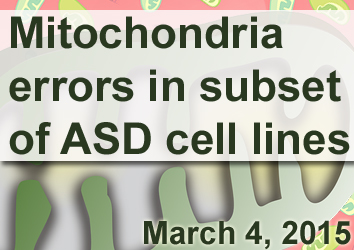Check out other stories from the Latest News
ASD Subset More Sensitive to Mitochondrial Stressors
By Shana R. Spindler, Ph.D. on March 4, 2015

Background: Mitochondria, the microscopic powerhouses of cells, provide energy for cellular functions throughout the body and brain. Several studies have linked mitochondrial damage or dysfunction to complex neurological disorders, including autism. Both genetic mutations and environmental insults can disrupt mitochondrial function.
What’s new: On January 21, 2015, the Journal of Toxicology published a study looking at mitochondrial sensitivity to oxidative stress (when the body fails to eliminate damaging free radicals in the cell) in 19 children with autistic disorder (AD) and 19 control individuals. The researchers used a type of blood cell to make cell lines—where cells grow and replicate in a petri dish—for their study. All of the cells derived from AD children had a baseline level of mitochondrial dysfunction compared to controls. The researchers reported a subset of AD children (31 percent) whose cells exhibited remarkably abnormal mitochondrial function when exposed to ethylmercury, a chemical known to cause oxidative stress. The pretreatment of these cells with an antioxidant-boosting drug before ethylmercury exposure improved mitochondrial function.
Why it’s important: Ethylmercury is most famous for its role as a metabolite of thiomerisal, the controversial preservative in some vaccines. The take home message from this study is not that ethylmercury—or a vaccine—causes autism, but that a subset of autistic individuals may be more sensitive to environmental stressors, such as oxidative stress, due to abnormal mitochondria function in cells. The authors of the study are quick to point out that any assumptions made about ethylmercury exposure in the living person based on these in vitro cell results would be “overstating and unsubstantiated.” Why the mitochondria of these individuals is more sensitive, and how that may affect brain function, remains an open question.
Help me understand :
| Source(s) : |
| Tweet |

